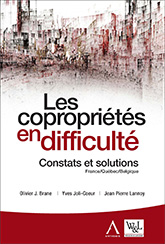Date published: 08/01/2025
Co-ownership in figures: France and Quebec face similar challenges
 Co-ownership, in both France and Quebec, represents a significant portion of the real estate market and raises issues of management, renovation, and governance. These collective housing units, whether residential buildings or row houses, require tailored approaches to ensure their sustainability. In France, co-ownerships are often associated with historic buildings, where energy renovation and heritage preservation take precedence. In Quebec, the challenges include harsh weather conditions, contingency fund management, and compliance with legal requirements for maintenance logbooks and contingency fund studies.
Co-ownership, in both France and Quebec, represents a significant portion of the real estate market and raises issues of management, renovation, and governance. These collective housing units, whether residential buildings or row houses, require tailored approaches to ensure their sustainability. In France, co-ownerships are often associated with historic buildings, where energy renovation and heritage preservation take precedence. In Quebec, the challenges include harsh weather conditions, contingency fund management, and compliance with legal requirements for maintenance logbooks and contingency fund studies.
Key figures for co-ownership in France
- Number of co-ownership homes: Around 9.7 million, or nearly 30% of the French residential stock.
- Number of co-ownership buildings: 800,000, of which 55% are small co-ownerships with 5 or fewer homes.
- Geographic distribution: The majority of co-ownerships are concentrated in urban areas, with major hubs in Paris, Lyon and Marseille.
- Average age of buildings: Many were built between 1945 and 1975, requiring work to bring them up to standard for insulation, safety and energy performance.
- Necessary work: 15 to 20% of co-ownerships must undertake major renovations, in particular to meet the energy transition objectives set by the Climate and Resilience Act.
- Condominium fees: On average, they amount to approximately €50/m² per year, with variations depending on the location and condition of the buildings.
- Governance and difficulties: 15% of condominium syndicates are in financial difficulty, while 60% of co-owners say they are unaware of their rights and obligations.
Key figures for co-ownership in Quebec
- Number of co-ownership units: 382,755, spread across more than 40,000 buildings.
- Geographic distribution: Greater Montreal accounts for approximately 80% of the province’s co-ownerships.
- Owner-occupiers: Nearly 70% of co-owners live in their unit, with the rest renting out on a long- or short-term basis.
- Age of buildings: The average age of co-ownerships is 29 years, which highlights the growing need for maintenance and renovation work.
- Condominium fees: They vary between $2,500 and $4,500 per year per unit, depending on the needs of the building.
- Insufficient contingency funds: Nearly 40% of co-ownerships do not have a sufficient contingency fund for major repairs, exposing co-owners to unforeseen costs.
Common challenges for co-owners
In both regions, the challenges of co-ownership are marked by:
- Aging buildings: Major renovation work is necessary to ensure the safety and durability of buildings.
- Financial management: Insufficient contingency funds are a recurring problem, often forcing co-owners to absorb unforeseen costs.
- The need for legal advice: With complex rules and a low participation rate at meetings, legal support is essential to ensure effective management and avoid conflicts.
These figures highlight the importance of a legal framework and appropriate governance to address the challenges of co-ownership, both in France and in Quebec. Professionals and unions must work closely together to ensure rigorous management and prevent critical situations.




